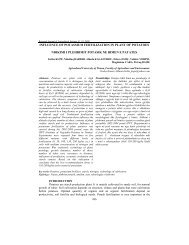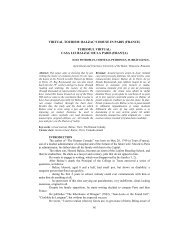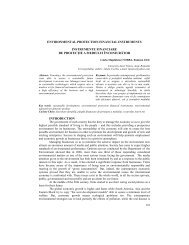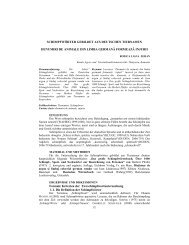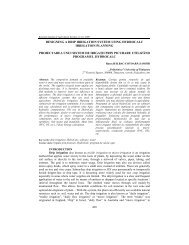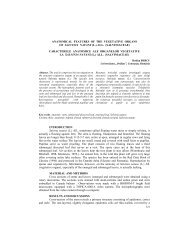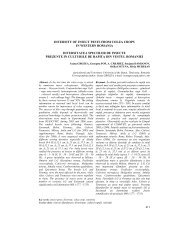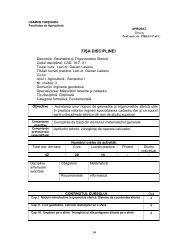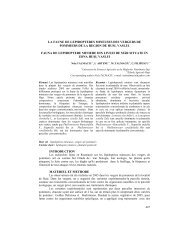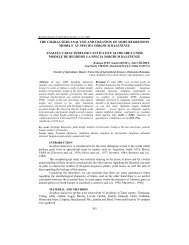Download - Research Journal of Agricultural Science
Download - Research Journal of Agricultural Science
Download - Research Journal of Agricultural Science
Create successful ePaper yourself
Turn your PDF publications into a flip-book with our unique Google optimized e-Paper software.
<strong>Research</strong> <strong>Journal</strong> <strong>of</strong> <strong>Agricultural</strong> <strong>Science</strong>, 41 (2), 2009<br />
COMPOUNDING AS THE WORD FORMATION TYPE OF INSECT NAMES<br />
IN GERMAN<br />
COMPUNEREA MOD DE FORMARE A DENUMIRILOR DE INSECTE IN<br />
LIMBA GERMANA<br />
Abstract: Compounding is a productive word<br />
formation process in German by which new words<br />
<strong>of</strong> any lexical category are formed. Most <strong>of</strong> the<br />
compounds are nouns and they obey the “righthand<br />
head rule” meaning that the rightmost word<br />
is a noun and determines the semantic and<br />
morphsyntactic properties. The present paper tries<br />
to classify the insect names in German according<br />
to this type <strong>of</strong> compounding.<br />
Key words: words, compound, modifier, head<br />
Cuvinte cheie: cuvint compus, baza, determinant<br />
518<br />
Rodica Liana ZEHAN<br />
USAMVB<br />
rodicazehan@ yahoo.com<br />
Rezumat: Comunerea este un process productive<br />
de formare a cuvintelor in limba germana cu<br />
ajutarul caruia cuvinte noi apartinind oricarei<br />
categorii lexicale sint formate. Cele mai multe<br />
cuvinte compuse sint substantive si ele urmeaza”<br />
regula minii drept”, acest lucru insemnind ca<br />
purtatorul caracteristicilor lexicale si<br />
morfosintactice esteultimul substantiv din partea<br />
dreapta. Actuala lucrare incearca sa clasifice<br />
numele germane de insecte conform acestui tip de<br />
compunere<br />
INTRODUCTION<br />
Composition is defined as a common very productive process by which words are put<br />
together to form a third more complex word meaning that two words are linked together to<br />
form a third one German composition is always binary, i.e. a word A plus a word B are put<br />
together and form a new word C. It must be underlined that both word A and word B can be in<br />
their turn compounds and in the process <strong>of</strong> compounding they are taken as single words.<br />
German compounds are commonly written as a single word. From the semantic point <strong>of</strong> view<br />
the German compounds can be classified as it follows: endocentric/Determinativkomposita,<br />
exocentric /Possessivkomposita-, and copulative /Kopulativkomposita (FLEISCHER, BARZ,<br />
1995)<br />
The goal <strong>of</strong> this paper is to analyze to what extend the insect names in German are<br />
formed by means <strong>of</strong> compounding and which types are mostly used.<br />
MATERIAL AND METHODS<br />
The linguistic investigation is carried out on a corpus <strong>of</strong> German insect names found<br />
in the following books: CHINERY, MICHAEL, 2004, Pareys Buch der Insekten, über 2000<br />
INSEKTEN EUROPAS, KOSMOS VERLAG, Stuttgart and REICHHOLF JOSEF, 2008, Schmetterlinge,<br />
BLV Buchverlag GmbH & Co KG, München.<br />
RESULTS AND DISCUSSIONS<br />
1. Endocentric compounds (Determinativkomposita)<br />
Most German insect names belong to the group <strong>of</strong> the endocentric compounds<br />
(Determinativkomposita). This type consists <strong>of</strong> two elements: the left-hand element called the<br />
modifier (Determnians or Bestimmungswort) and the right hand element called the head
<strong>Research</strong> <strong>Journal</strong> <strong>of</strong> <strong>Agricultural</strong> <strong>Science</strong>, 41 (2), 2009<br />
(Determinant or Grundwort) <strong>of</strong> the compound. It must be underlined that the head <strong>of</strong><br />
compounds in German always occurs on the right hand side i.e. it obeys the so called “righthand<br />
head rule” (WILLIAMS, 1981), which means that the head determines the semantic<br />
and morphosyntactic properties <strong>of</strong> the noun (gender, number and case).<br />
The modifier can be a noun, an adjective, a verb or a numeral. The noun modifier has<br />
sometimes an inflection that can be either the plural form <strong>of</strong> the noun or its genitive form.<br />
According to this criteria this large group can be divided as it follows, when taking<br />
into consideration the modifier<br />
1.1. N + N.<br />
By far this is the most common type <strong>of</strong> compounds <strong>of</strong> the German insect names.<br />
According to ELKE DONALIES (2007) this is the oldest type <strong>of</strong> German compounds.<br />
Aaskäfer, Ameisenwanze, Adonislibelle, Augenfalter, Bachläufer, Birkenspanner,<br />
Birkenspinner, Blattflöhe, Blattkäfer, Blattlaus, Blutzykade, Brotkäfer, Bienenkäfer,<br />
Feuerfalter, Distelfalter, Feuerfalter, Feuerlibelle,Fliegenkäfer, Frostspanner, Mistkafer,<br />
Feldgille, Gartenwanze, Goldwespe, Halmfliege, Pelzbiene, Sandbiene, Märzfliege, Maikäfer,<br />
Julikäfer, Junikäfer, Hirschkäfer, Kugekkäfer, Kugelwanze, Laubfalter, Lederwanze,<br />
Lindenwanze, Maikäfer, Maizünsler, Malvenwanze, Möhrenrüssler, Mehlkäfer, Mistbiene,<br />
Nesselzünsler, Ohrwurm, Ohrzykade, Ölkäfer, Pechlibelle, Rübenzünsler, Rüsselkäfer,<br />
Samenmotte, Saumwanze, Tabakkäfer, Sumpfkäfer, Tannenlaus, Teppichkäfer, Totenkäfer,<br />
Waldgrille, Wasserskorpion, Wollkäfer,;<br />
Words like Auge, Bach, Blatt, Baum, Birke, Blut, Eiche, Fichte, Getreide, Gemüse,<br />
Gold, Holz, Kiefer, Kohl, Pflaume, Rübe, Toten, Trauer, Wald, Wasser, Weide, Wiese and<br />
Winter are mostly used as modifiers, whereas Biene, Laus, Käfer, Falter, Spanner, Wanze,<br />
Wurm, Zykade are the most common heads.<br />
German insect names belonging to this type and having more than 2 elements are rare<br />
but they exist. In this case either the modifier or the head can be a compound or even both.<br />
1.1.2. N (a simplex) + N (a compound)<br />
Ameisenbuntkäfer, Baumschwammkäfer, Eichenprachtkäfer, Bienenschwebefliege,<br />
Bindenblutzykade, Blatthornkäfer, Ameisen-Sackkäfer, Sandlaufkäfer, Frühlingsmistkäfer<br />
1.1.3. N (a compound) + N (a simplex)<br />
Ödlandschrecke, Beilfleckwidderchen, Bergahornwickler, Maulwurfsgrille,<br />
Schachbrettfalter, Totenkopfschwärmer, Därrobstmotte,<br />
1.1.4. N (compound) + N(compound)<br />
Bergahorn-Winterzykade, Bergwaldlaufkäfer, Bilsenkraut-Blüteneule,<br />
Keilfleckschwebfliege<br />
1.2. Adjective + N<br />
Blindbremse, Breitrussler, Buntkafer, Bunteulchen, Edelfalter,Schmalbock,<br />
Schnellkäfer,<br />
The number <strong>of</strong> German insect names having an adjective as modifier is very small<br />
and only the monosyllabic adjectives are used in such cases.<br />
1.2.1 Multiple compounding with advectives<br />
Braundickkopffalter- In this particular case the modifier is an adjective “braun” and<br />
519
<strong>Research</strong> <strong>Journal</strong> <strong>of</strong> <strong>Agricultural</strong> <strong>Science</strong>, 41 (2), 2009<br />
the head is a compound Dickkopffalter consisting <strong>of</strong> a modifier “Dickkopf” and a head<br />
“Falter”. Such compounds are very rare. In “Langbauchschwebfliege” both the modifier and<br />
the head are compounds. The modifier hasas component parts an adjective and a noun. The<br />
head in its turn is formed by a verb stem and a noun.<br />
1.3. Verb + N<br />
Laufspinne, Bohrkafer, Bohrfliege, Beißschrecke, Zitterspinne, Springbock<br />
Schwebfliege, Moderkäfer, Stinkwanze, Schwimmwanze, Schlupfwespe, Schmeißfliege,<br />
Taumelkäfer, Bombardierkäfer, Glühwürmchen, Schwebfliege, Raubfliege, Stechmücke,<br />
Zuckmücke, Springschwanz, Fangwanze, Schmierlaus, Zuckmücke, Stelzmücken,<br />
Stolperkäfer, Stuzkäfer .<br />
When looking closer to the compound German insect names, which have a verb as a<br />
modifier we can say that the verb stem is used to form the modifier. The only verb ending in -<br />
ieren that forms a modifier is “bombardieren”.<br />
2. The Exocentric compounds form the second group <strong>of</strong> compounds. Another term<br />
for this class <strong>of</strong> compounds is bahuvrihi a word coming from the ancient Sanskrit grammar.<br />
Sometimes these compounds are also called Possessivkomposita (possessive compounds) as<br />
the compounds denote the property. The exocentric compounds do not have a semantic head,<br />
meaning that they cannot be understood from words building them up. An “Erpelschwanz”<br />
(large Chocolate –tip) is not a “Schwanz”(tail) <strong>of</strong> an Erpel (duck) . It is a butterfly named in<br />
German after the position <strong>of</strong> the wings,- giving the impression <strong>of</strong> a duck tail - when standing<br />
still. In such compounds the relation is a metaphoric or a “pars pro toto” one.<br />
But if other properties regarding these compounds are taken into consideration it must<br />
be said that the part <strong>of</strong> speech is inherited from the right hand rule, as it is the case with the<br />
endocentric compounds. So from the standpoint <strong>of</strong> their morphological properties these<br />
compounds behave just like their endocentric counterparts.<br />
Pfauenauge, Blaupfeil, Granatauge, Heupferd, Kaisermantel, Landkärtchen,<br />
Nierenfleck, Ochsenauge, Plattbauch, schwalbenchwanz, Totengräber, Trauermantel,<br />
Vierfleck, Buntrock,<br />
CONCLUSIONS<br />
As a conclusion it can be said that most <strong>of</strong> the German insect names belong to the<br />
endocentric compounds. The greatest part is formed by a simple modifier and a simple head.<br />
Modifiers can be nouns, adjectives and verb stems. As a peculiarity it can be noticed that no<br />
endocentric compound has a numeral as modifier. There are also German insect names that are<br />
formed by multiple compounding. In this case either the modifier <strong>of</strong> the head or even both can<br />
be compounds.<br />
There are by far less exocentric compounds among the German insect names. As the<br />
meaning must be sought outside the compound, metonymy is the most used means <strong>of</strong> building<br />
such compounds.<br />
BIBLIOGRAFY<br />
1. DONALIES, ELKE, Basiswissen Deutsche Wortbildung, A Francke Verlag, Tübingen-Basel,2007.<br />
2. DUDEN, „Grammatik der deutschen Gegenwartssprache“, Bd. 4, Dudenverlag, 2005.<br />
3.FLEISCER, W., BARZ, I., „Wortbildung der deutschen Gegenwartssprache“, Niemeyer Verlag, Tübingen,<br />
1995.<br />
4. GOZMANY, L., „Vocabularum Nominum Animalium Europae, septem linguis redactum I”, Akadémiai<br />
520
<strong>Research</strong> <strong>Journal</strong> <strong>of</strong> <strong>Agricultural</strong> <strong>Science</strong>, 41 (2), 2009<br />
Kiradó, Budapest,1979.<br />
5. HENSCHEL, E., WAGNER, G., „Zoologisches Wörterbuch”,4. Auflage,VEB Gustav Fischer Verlag, Jena,<br />
1990.<br />
6. KLUGE, FR., „Etymologisches Wörterbuch der deutschen Sprache“, de Gruyter, Berlin,1989.<br />
7. SCHIPPAN, TH., „Lexikologie der deutschen Gegenwartssprache“ Max Niemeyer Verlag, Tübingen,<br />
1992.<br />
8. WISSMANN, W.,”Wörterbuch der deutschen Tiernamen”, Lieferungen 1-6; Insekten, bearbeitet von<br />
W.Pfeifer, Akademie Verlag, Berlin, 1966-1968.<br />
9. WAHRIG, G., „Deutsches Wörterbuch”, Bertelsmann Lexikon Verlag, 1999.<br />
10. CHINERY, MICHAEL, 2004, Pareys Buch der Insekten, über 2000 Insekten Europas,Kosmos Verlag,<br />
Stuttgart.<br />
11. WILLIAMS, EDWIN, 1981, „On the Notions „Lexically related“ and “head <strong>of</strong> a word”, in Lingustic<br />
Inquiry, No. 12,<br />
12. REICHHOLF JOSEF, Schmetterlinge, BLV Buchverlag GmbH & Co KG, München2008.<br />
13. XXX „Der farbige Brehm- ein großes Tierbuch mit 120 Farbtafeln”, Herder, Freiburg, Basel, Wien,<br />
1978.<br />
521




